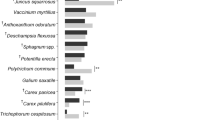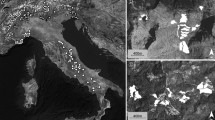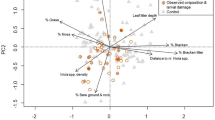Abstract
Amongst oviparous animals, the spatial distribution of individuals is often set initially by where females lay eggs, with potential implications for populations and species coexistence. Do the spatial arrangements of oviposition sites or female behaviours determine spatial patterns of eggs? The consequences of spatial patterns may be context independent if strong behaviours drive patterns; context dependent if the local environment dominates. We tested these ideas using a guild of stream-dwelling caddisflies that oviposit on emergent rocks, focussing on genera with contrasting behaviours. In naturally occurring oviposition landscapes (riffles with emergent rocks), we surveyed the spatial arrangement and environmental characteristics of all emergent rocks, identified and enumerated egg masses on each. Multiple riffles were surveyed to test for spatially invariant patterns and behaviours. In landscapes, we tested for spatial clumping of oviposition sites exploited by each species and for segregation of congeneric species. At oviposition sites, we characterised the frequency distributions of egg masses and tested for species associations. Genus-specific behaviours produced different spatial patterns of egg masses in the same landscapes. Congregative behaviour of Ulmerochorema spp. at landscape scales and an aggregative response at preferred oviposition sites led to clumped patterns, local aggregation and species overlap. In contrast, avoidance behaviours by congeners of Apsilochorema resulted in no or weak clumping, and species segregation in some landscapes. Spatial patterns were consistent across riffles that varied in area and oviposition site density. These results suggest that quite different oviposition behaviours may be context independent, and the consequences of spatial patterns may be spatially invariant also.



Similar content being viewed by others
References
Anderson P (2002) Oviposition pheromones in herbivorous and carnivorous insects. In: Hilker M, Meiners T (eds) Chemoecology of insect eggs and egg deposition. Blackwell Publishing Ltd, Berlin, pp 235–263
Atkinson WD, Shorrocks B (1984) Aggregation of larval Diptera over discrete and ephemeral breeding sites: the implications for coexistence. Am Nat 124:336–351. https://doi.org/10.1086/284277
Baddeley AJ, Møller J, Waagepetersen R (2000) Non- and semi-parametric estimation of interaction in inhomogeneous point patterns. Stat Neerl 54:329–350. https://doi.org/10.1111/1467-9574.00144
Baddeley A, Diggle PJ, Hardegen A, Lawrence T, Milne RK, Nair G (2014) On tests of spatial pattern based on simulation envelopes. Ecol Monogr 84:477–489. https://doi.org/10.1890/13-2042.1
Baddeley A, Rubak E, Turner R (2016) Spatial point patterns: methodology and applications with R. Chapman and Hall/CRC Press, Boca Raton
Besag J (1977) Contribution to the discussion of Dr Ripley’s paper. J R Stat Soc B 39:193–195
Bovill WD (2013) The recruitment dynamics of stream insect larvae: oviposition and egg mortality of hydrobiosid caddisflies. PhD Thesis, The University of Melbourne, Melbourne, Australia
Bovill WD, Downes BJ, Lancaster J (2013) A test of the preference–performance hypothesis in stream insects: selective oviposition affects the hatching success of caddisfly eggs. Freshw Biol 58:2287–2298. https://doi.org/10.1111/fwb.12209
Bovill WD, Downes BJ, Lancaster J (2015) Caddisfly egg mass morphology mediates egg predation: potential costs to individuals and populations. Freshw Biol 60:360–372. https://doi.org/10.1111/fwb.12497
Chesson P (2008) Quantifying and testing species coexistence mechanisms. In: Valladares F, Camacho A, Elosegui A, Gracia C, Estrada M, Senar JC, Gili JM (eds) Unity in diversity: reflections on ecology after the legacy of Ramon Margalef. Fundacion BBVA, Bilbao, pp 119–164
Desurmont GA, Weston PA (2011) Aggregative oviposition of a phytophagous beetle overcomes egg-crushing plant defences. Ecol Entomol 36:335–343. https://doi.org/10.1111/j.1365-2311.2011.01277.x
Doak P (2000) Population consequences of restricted dispersal for an insect herbivore in a subdivided habitat. Ecology 81:1828–1841. https://doi.org/10.1890/0012-9658(2000)081[1828:PCORDF]2.0.CO;2
Doumbia M, Hemptinne J-L, Dixon A (1998) Assessment of patch quality by ladybirds: role of larval tracks. Oecologia 113:197–202
Encalada AC, Peckarsky BL (2007) A comparative study of the costs of alternative mayfly oviposition behaviors. Behav Ecol Sociobiol 61:1437–1448. https://doi.org/10.1007/s00265-007-0376-4
Encalada AC, Peckarsky BL (2012) Large-scale manipulation of mayfly recruitment affects population size. Oecologia 168:967–976. https://doi.org/10.1007/s00442-011-2147-1
Fagan WF, Folarin A (2001) Contrasting scales of oviposition and parasitism in praying mantids. Popul Ecol 43:87–96
Gabel B, Thiéry D (1992) Biological evidence of an oviposition-deterring pheromone in Lobesia botrana Den. et Schiff. (Lepidoptera, Tortricidae). J Chem Ecol 18:353–358. https://doi.org/10.1007/bf00994236
Gordon ND, McMahon TA, Finlayson BL, Gippel CJ, Nathan RJ (2004) Stream hydrology: an introduction for ecologists, 2nd edn. John Wiley & Sons, Chichester
Gripenberg S, Mayhew PJ, Parnell M, Roslin T (2010) A meta-analysis of preference–performance relationships in phytophagous insects. Ecol Lett 13:383–393
Haddow AJ, Corbet PS (1961) Entomological studies from a high tower in Mpanga Forest, Uganda. Trans R Entomol Soc Lond 113:284–300. https://doi.org/10.1111/j.1365-2311.1961.tb02288.x
Hassell MP, Pacala SW (1990) Heterogeneity and the dynamics of host—parasitoid interactions. Philos Trans R Soc Lond Ser B Biol Sci 330:203–220
Heard SB (1998) Resource patch density and larval aggregation in mushroom-breeding flies. Oikos 81:187–195. https://doi.org/10.2307/3546480
Hildrew AG, Wagner R (1992) The briefly colonial life of hatchlings of the net-spinning caddisfly Plectrocnemia conspersa. J N Am Benthol Soc 11:60–68. https://doi.org/10.2307/1467882
Huffaker CB (1958) Experimental studies on predation: dispersion factors and predator-prey oscillations. Hilgardia 27:343–383. https://doi.org/10.3733/hilg.v27n14p343
Ives AR (1988) Aggregation and coexistence of competitors. Ann Zool Fenn 25:75–88
Ives AR (1991) Aggregation and coexistence in a carrion fly community. Ecol Monogr 61:75–94. https://doi.org/10.2307/1943000
Jones R (1977) Movement patterns and egg distribution in cabbage butterflies. J Anim Ecol 46:195–212
Kőrösi Á, Örvössy N, Batáry P, Kövér S, Peregovits L (2008) Restricted within-habitat movement and time-constrained egg laying of female Maculinea rebeli butterflies. Oecologia 156:455–464
Kouki J (1991) Tracking spatially variable resources: an experimental study on the oviposition of the water-lily beetle. Oikos 61:243–249. https://doi.org/10.2307/3545342
Lancaster J, Downes BJ (2004) Spatial pattern analysis of available and exploited resources. Ecography 27:94–102. https://doi.org/10.1111/j.0906-7590.2004.03694.x
Lancaster J, Downes BJ (2013) Aquatic entomology. Oxford University Press, UK
Lancaster J, Downes BJ (2014a) Maternal behaviours may explain riffle-scale variations in some stream insect populations. Freshw Biol 59:502–513. https://doi.org/10.1111/fwb.12281
Lancaster J, Downes BJ (2014b) Population densities and density-area relationships in a community with advective dispersal and variable mosaics of resource patches. Oecologia 176:985–996. https://doi.org/10.1007/s00442-014-3062-z
Lancaster J, Downes BJ (2018) Aquatic versus terrestrial insects: real or presumed differences in population dynamics? Insects 9(4):157. https://doi.org/10.3390/insects9040157
Lancaster J, Glaister A (2019) Egg masses of some stream-dwelling caddisflies (Trichoptera: Hydrobiosidae) from Victoria, Australia. Austral Entomol 58:561–568. https://doi.org/10.1111/aen.12360
Lancaster J, Downes BJ, Reich P (2003) Linking landscape patterns of resource distribution with models of aggregation in ovipositing stream insects. J Anim Ecol 72:969–978. https://doi.org/10.1046/j.1365-2656.2003.00764.x
Lancaster J, Downes BJ, Arnold A (2010a) Environmental constraints on oviposition limit egg supply of a stream insect at multiple scales. Oecologia 163:373–384. https://doi.org/10.1007/s00442-010-1565-9
Lancaster J, Downes BJ, Arnold A (2010b) Oviposition site selectivity of some stream-dwelling caddisflies. Hydrobiologia 652:165–178. https://doi.org/10.1007/s10750-010-0328-2
Lancaster J, Downes BJ, Arnold A (2011) Lasting effects of maternal behaviour on the distribution of a dispersive stream insect. J Anim Ecol 80:1061–1069. https://doi.org/10.1111/j.1365-2656.2011.01847.x
Löfstedt C, Hansson BS, Petersson E, Valeur P, Richards A (1994) Pheromonal secretions from glands on the 5th abdominal sternite of hydropsychid and rhyacophilid caddisflies (Trichoptera). J Chem Ecol 20:153–170. https://doi.org/10.1007/BF02065998
Lounibos LP (1981) Habitat segregation among African treehole mosquitoes. Ecol Entomol 6:129–154. https://doi.org/10.1111/j.1365-2311.1981.tb00601.x
Mattingly WB, Flory SL (2011) Plant architecture affects periodical cicada oviposition behavior on native and non-native hosts. Oikos 120:1083–1091
McPeek MA (2017) The ecological dynamics of natural selection: traits and the coevolution of community structure. Am Nat 189:E91–E117. https://doi.org/10.1086/691101
Melnitsky S, Ivanov V (2011) Structure and localization of sensilla on antennae of caddisflies (Insecta: Trichoptera). J Evol Biochem Physiol 47:593–602
Menge BA (1976) Organization of the New England rocky intertidal community: role of predation, competition, and environmental heterogeneity. Ecol Monogr 46:355–369. https://doi.org/10.2307/1942563
Miller RS (1967) Pattern and process in competition. In: Cragg JB (ed) Adv Ecol Res, vol 4. Academic Press, Cambridge, pp 1–74
Morris WF, Wiser SD, Klepetka B (1992) Causes and consequences of spatial aggregation in the phytophagous beetle Alticatombacina. J Anim Ecol. https://doi.org/10.2307/5508
Neboiss A (1986) Atlas of Trichoptera of the SW Pacific-Australia region. Dr W Junk, Dordrecht
Peckarsky BL, Taylor BW, Caudill CC (2000) Hydrologic and behavioral constraints on oviposition of stream insects: implications for adult dispersal. Oecologia 125:186–200. https://doi.org/10.1007/s004420000446
R Core Development Team (2017) R: a language and environment for statistical computing. R Foundation for Statistical Computing, Vienna
Refsnider JM, Janzen FJ (2010) Putting eggs in one basket: Ecological and evolutionary hypotheses for variation in oviposition-site choice. Annu Rev Ecol Evol Syst 41:39–57. https://doi.org/10.1146/annurev-ecolsys-102209-144712
Reich P (2002) The egg masses of lotic invertebrates: proximate cues for oviposition site selection and implications for larval abundance and distribution. Ph.D. Thesis, The University of Melbourne, Victoria, Australia
Reich P (2004) Patterns of composition and abundance in macroinvertebrate egg masses from temperate Australian streams. Mar Freshw Res 55:39–56. https://doi.org/10.1071/MF03129
Reich P, Downes BJ (2003a) The distribution of aquatic invertebrate egg masses in relation to physical characteristics of oviposition sites at two Victorian upland streams. Freshw Biol 48:1497–1513. https://doi.org/10.1046/j.1365-2427.2003.01101.x
Reich P, Downes BJ (2003b) Experimental evidence for physical cues involved in oviposition site selection of lotic hydrobiosid caddisflies. Oecologia 136:465–475. https://doi.org/10.1007/s00442-003-1284-6
Reich P, Hale R, Downes BJ, Lancaster J (2011) Environmental cues or conspecific attraction as casues for egg mass aggregation in hydrobiosid caddisflies. Hydrobiologia 661:351–362. https://doi.org/10.1007/s10750-010-0543-x
Renwick JAA, Chew FS (1994) Oviposition behavior in Lepidoptera. Annu Rev Entomol 34:377–400. https://doi.org/10.1146/annurev.en.39.010194.002113
Resetarits WJ Jr (2001) Colonization under threat of predation: avoidance of fish by an aquatic beetle, Tropisternus lateralis (Coleoptera: Hydrophilidae). Oecologia 129:155–160. https://doi.org/10.1007/s004420100704
Resh VH, Wood JR (1985) Site of sex pheromone production in three species of Trichoptera. Aquat Insects 7:65–71. https://doi.org/10.1080/01650428509361202
Ripley BD (1976) The second-order analysis of stationary processes. J Appl Probab 13:255–266. https://doi.org/10.2307/3212829
Schoonhoven LM, Beerling EAM, Klijnstra JW, van Vugt Y (1990) Two related butterfly species avoid oviposition near each other’s eggs. Experientia 46:526–528. https://doi.org/10.1007/bf01954255
Schtickzelle N, Joiris A, Van Dyck H, Baguette M (2007) Quantitative analysis of changes in movement behaviour within and outside habitat in a specialist butterfly. BMC Evol Biol 7:4
Schultz CB, Franco AM, Crone EE (2012) Response of butterflies to structural and resource boundaries. J Anim Ecol 81:724–734
Southwood TRE (1978) Ecological methods, 2nd edn. Chapman and Hall, London
Städler E (2002) Plant chemical cues important for egg deposition by herbivorous insects. In: Hilker M, Meiners T (eds) Chemoecology of insect eggs and egg deposition. Blackwell Science, Berlin, pp 171–204
Vertacnik KL, Linnen CR (2017) Evolutionary genetics of host shifts in herbivorous insects: insights from the age of genomics. Ann N Y Acad Sci 1389:186–212
Warren-Rhodes KA, Dungan JL, Piatek J, Stubbs K, Gómez-Silva B, Chen Y, McKay CP (2007) Ecology and spatial pattern of cyanobacterial community island patches in the Atacama Desert Chile. J Geophys Res Biogeosci 112:G04S15
With KA, King AW (1997) The use and misuse of neutral landscape models in ecology. Oikos 79:219–229. https://doi.org/10.2307/3546007
Acknowledgements
This research was supported by a Discovery grant from the Australian Research Council (DP 160102262). We are deeply indebted to the assistants who helped collect these data: Courtney Cummings, David Dodemaide, Alena Glaister, Ashley Macqueen and Rafael Schouton. Thanks to Peter Grant for facilitating access to Snobs Ck. Field work was carried out in conjunction with a Research Permit (No. 10007855) under the National Parks Act (Australia), from the Department of Environment, Land, Water and Planning (Victoria).
Author information
Authors and Affiliations
Contributions
All authors conceived and designed the study. JL, BD and RL collected the data. JL carried out the numerical analyses. JL and BD led the data interpretation and writing. All authors contributed critically to writing the paper and approved the final draft.
Corresponding author
Additional information
Communicated by David Chalcraft.
Electronic supplementary material
Below is the link to the electronic supplementary material.
Rights and permissions
About this article
Cite this article
Lancaster, J., Downes, B.J., Lester, R.E. et al. Avoidance and aggregation create consistent egg distribution patterns of congeneric caddisflies across spatially variable oviposition landscapes. Oecologia 192, 375–389 (2020). https://doi.org/10.1007/s00442-019-04587-7
Received:
Accepted:
Published:
Issue Date:
DOI: https://doi.org/10.1007/s00442-019-04587-7




